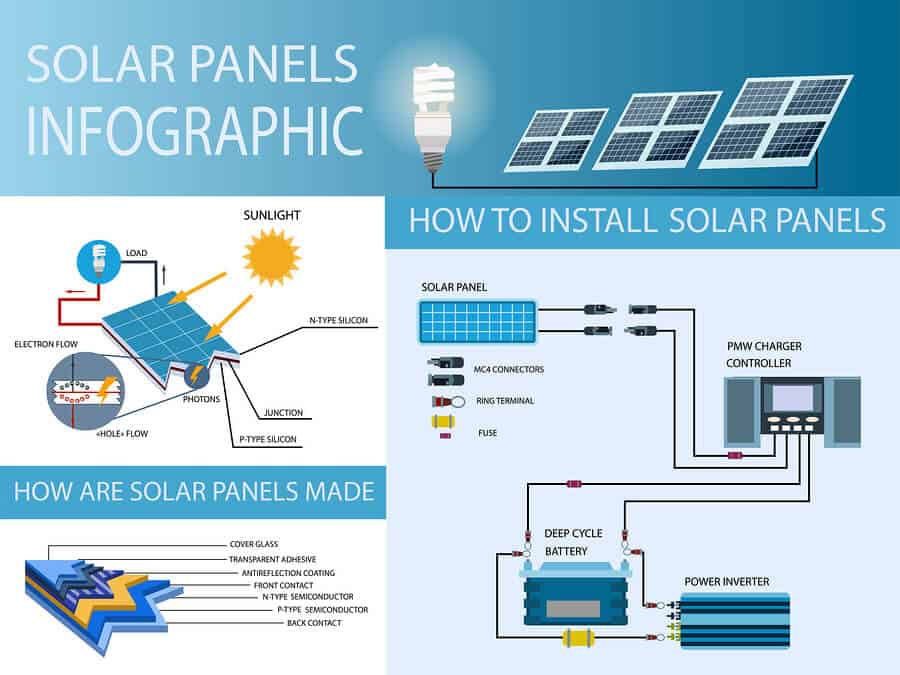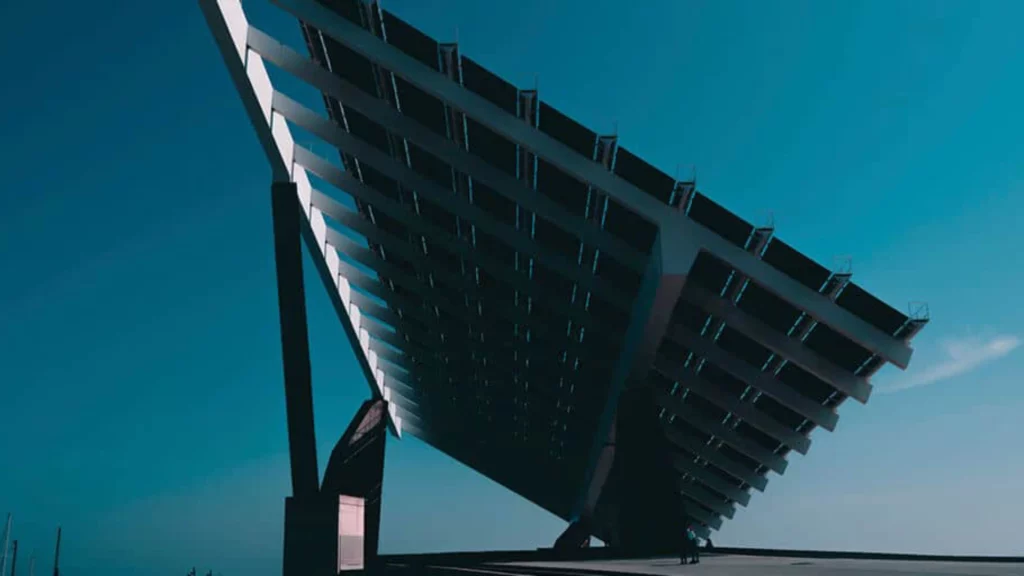As I delve into the realm of solar energy and its potential to revolutionize our power sources, I find myself captivated by the question, “How do solar panels work?” This question takes on a personal significance as I consider harnessing the power of the sun to meet my own energy needs, particularly for my home and roof.
In this personal exploration, I aim to uncover the intricacies of solar panel functionality and understand how they can seamlessly integrate into my home and roof structure. By unraveling the science behind solar energy conversion, I hope to make informed decisions that align with my desire for a sustainable and eco-friendly lifestyle.
Understanding How do Solar Panels Work on a House
The sun sends out protons which are small particles of energy that hit the earth. A solar panel that is hit by a proton will knock the electrons loose from the atoms in that proton. The solar panel then forms an electrical circuit. When the electrons flow through the circuit of a solar panel they will generate electricity.
There are many cells that make up a solar panel and there are multiple panels called modules which are in the solar panel. These are all wired together and we call this a solar array. The more we know about how do solar panels work that you have deployed the more energy you were able to generate with the solar panel.
All you need to know is that the solar panel is collecting energy from the sun and turning its energy into electricity and power.
See Also Our Post on Photovoltaic Cells: How Do They Work and How Can They Save You Money?

What They Are Made of
Solar panels are made up of several essential components that work together to convert sunlight into electricity. Here are the key elements that make up a typical solar panel:
Solar Cells
Solar cells, also known as photovoltaic cells, are the heart of a solar panel. They are typically made of silicon, a semiconductor material. The silicon is specially treated to create a positive and negative layer, forming a p-n junction. When sunlight strikes the solar cells, it excites the electrons in the material, generating an electric current. The solar cells are connected in series and/or parallel to achieve the desired voltage and current output.
Encapsulation
Solar cells are encapsulated to protect them from environmental factors and ensure their longevity. The encapsulation process involves laminating the solar cells between layers of specialized materials. The most common encapsulation materials are ethylene-vinyl acetate (EVA) and a protective backsheet made of polymer or aluminum.
Glass Cover
The front of a solar panel is covered with a tempered glass sheet. This glass cover provides protection against external elements such as rain, snow, and hail, while allowing sunlight to pass through and reach the solar cells.
Frame
Solar panels are framed to provide structural support and protect the internal components. The frame is typically made of aluminum or stainless steel, providing rigidity and durability.
Busbars and Conductive Ribbons
Busbars are thin metal strips made of silver or copper that collect the electrical current generated by the solar cells. They are located on the top surface of the solar cells and serve as pathways for the current to flow. Conductive ribbons are used to connect the busbars to the electrical contacts on the backside of the solar cells.
Backsheet
The backside of a solar panel is covered with a backsheet, which provides insulation and protection for the solar cells and the electrical components. The backsheet is designed to withstand temperature variations and protect against moisture and other environmental factors.
Junction Box
The junction box is an important component located on the backside of the solar panel. It contains diodes and connectors that allow for the safe and efficient electrical connection of multiple panels in a solar array. The junction box also serves as a connection point for the wiring that carries the generated electricity.
The inverter is basically the brain of how do solar panels work to generate electricity.
It inverts the DC power to AC power and provides ground fault protection as well as system stats for the solar panel array.
It will include the AC and DC circuits as well as the voltage. it will also provide the maximum power point tracking and energy production of the solar panel This inverter helps you understand what is going on with your solar panel system.
In the beginning, we used to use central inverters but we now use micro inverters as this has been a large technological shift in the solar panel industry. A micro inverter is optimized for each one of your solar panels and not the entire solar panel system like a central inverter.
When you have a micro inverter this enables each solar panel to operate at its maximum potential. When you use a central inverter you might have a problem with one solar panel and this problem can drag down the performance of all of your solar panels.
Read our post about Low Light Solar Panels and how they work
How do Solar Panels Work Installation
When it comes to installing solar panels, the chosen installation method plays a critical role in optimizing their performance and efficiency. There are two primary options to consider:
Roof-Mounted Systems
Roof-mounted systems are the most common and popular installation method for residential and commercial buildings. Here's a closer look at the key aspects of roof-mounted solar panel installations:
- Mounting Brackets and Racking Systems: Solar panels are securely mounted on the roof using specially designed mounting brackets and racking systems. These brackets and racks are carefully positioned and attached to the roof structure to ensure stability and longevity.
- Sunlight Exposure Maximization: Roof-mounted systems are strategically positioned to maximize exposure to sunlight throughout the day. The tilt angle and orientation of the panels are optimized based on the geographical location and the roof's characteristics, such as its slope and direction.
- Space Efficiency: By utilizing the available roof space, roof-mounted systems offer excellent space efficiency. They make efficient use of otherwise unused or underutilized areas on rooftops, allowing for the installation of a significant number of panels.
- Aesthetics and Integration: Roof-mounted solar panels are seamlessly integrated into the existing structure, resulting in a visually pleasing appearance. The panels become a part of the building's architecture and blend in with the roof's design, preserving the aesthetic appeal.
Ground-Mounted Systems
Ground-mounted systems are an ideal choice when ample space is available on the property and the roof is not suitable for solar panel installation. Here are the key features of ground-mounted solar panel installations:
- Flexible Positioning and Angle Adjustment: With ground-mounted systems, solar panels are installed on a dedicated structure, such as a pole or frame, positioned on the ground. This setup allows for flexibility in selecting the optimal location and adjusting the tilt angle of the panels to maximize sunlight capture. It ensures that the panels are perfectly aligned to receive the maximum solar irradiation throughout the year.
- Optimal Sunlight Exposure: Ground-mounted systems offer the advantage of being able to position the panels in an area with the highest solar exposure. Obstructions such as shading from nearby buildings or trees can be minimized or eliminated, ensuring optimal performance and energy generation.
- Accessibility and Maintenance: Ground-mounted systems are easily accessible, facilitating maintenance and cleaning tasks. Technicians can easily access the panels for routine inspections, cleaning, and any necessary repairs, reducing the need for complex equipment or extensive roof access.
- Scalability and Expansion: Ground-mounted systems provide greater flexibility for scalability and expansion. Additional panels can be easily added to the ground-mounted structure, allowing for future expansion of the solar power system as energy needs grow or as the property evolves.
In both roof-mounted and ground-mounted installations, it is essential to consult with a professional solar installer or contractor who can assess the site, evaluate the structural integrity, and determine the most suitable installation approach based on factors such as sunlight availability, space constraints, and local regulations.

200 Watt Solar Panels: A Sustainable Power Solution
In the journey towards cleaner, more sustainable energy sources, 200-watt solar panels emerge as an efficient and compact solution for various power needs. This level of power capacity hits a sweet spot for many individuals and small businesses, providing enough energy for a variety of applications without occupying too much space or demanding significant investment.
These panels are ideal for off-grid applications, including RVs, boats, and remote cabins. A 200-watt solar panel can power small appliances, charge batteries, and keep your electronic devices running smoothly while you're out enjoying nature. Furthermore, the use of these panels in residential settings is gaining popularity as well. They can supplement grid electricity, reducing your reliance on fossil fuels and lowering energy bills.
Check out this great video by Richard Komp.
Embracing the Benefits of Solar Panels
Solar panels have emerged as a transformative technology, offering a multitude of benefits for individuals and the environment alike. Let's dive deeper into the remarkable advantages that solar panels bring:
Clean and Renewable Energy
At the forefront of solar panels' appeal is their ability to harness the power of the sun, offering a clean and renewable source of electricity. Unlike conventional energy generation methods reliant on fossil fuels, solar panels produce electricity without emitting harmful pollutants or greenhouse gases. By tapping into the vast solar energy resources, we can reduce our carbon footprint and contribute to a more sustainable future.
Read also our post on Renewable Energy Corporation (REC)
Energy Cost Savings
One of the most tangible benefits of installing solar panels is the potential for substantial energy cost savings. By generating your own electricity, you can significantly reduce or even eliminate your reliance on power supplied by the electrical grid. As the sun's energy becomes your primary source of electricity, you can drastically lower your monthly utility bills, leading to long-term financial savings.
Energy Independence
Solar panels offer the opportunity to achieve energy independence. By producing your own electricity, you become less reliant on utility companies and the fluctuations in energy prices. Solar energy empowers individuals to take control of their energy needs and reduce their vulnerability to grid outages or disruptions. With solar panels, you can enjoy a more self-sufficient and reliable energy supply.
Long-Term Investment
Investing in solar panels is not only an environmentally conscious decision but also a wise long-term investment. When you install solar panels on your property, you are essentially adding value to your home or business. Solar-equipped properties are highly sought after in the real estate market, attracting eco-conscious buyers and potentially commanding a higher selling price. As solar technology continues to advance, your solar panel system can provide a reliable and sustainable source of energy for years to come, enhancing the overall value of your property.
Environmental Benefits
By embracing solar panels, you become an active participant in creating a greener and more sustainable future. Solar energy reduces the demand for fossil fuels, which helps to conserve natural resources and minimize environmental degradation associated with extraction and combustion processes. Furthermore, solar panels contribute to the reduction of carbon emissions, playing a crucial role in mitigating climate change and preserving the planet for future generations.
The Functioning of How do Solar Panels Work
To truly understand how do solar panels work, it is essential to delve into the detailed process that unfolds within these remarkable devices. Let's explore the functioning of solar panels by breaking it down into the following steps:
Step 1: Absorption of Sunlight
When sunlight reaches the solar panels, it encounters a surface made up of solar cells. These solar cells are predominantly composed of silicon, a semiconductor material. As the photons, which are particles of light, strike the surface of the solar cells, they transfer their energy to the electrons present within the semiconductor material.
This energy transfer causes the electrons to gain energy, becoming excited and breaking free from their atomic bonds. The presence of specific impurities within the semiconductor material, intentionally added during the manufacturing process, enhances this absorption and energy transfer mechanism.
Step 2: Photovoltaic Conversion
Once the electrons are liberated from their atoms, an electric field within the solar cells exerts a force on these charged particles. This electric field, created by the structure of the solar cells, directs the electrons to move in a specific direction. As the electrons move, a flow of electrical current is generated.
The movement of the electrons in a consistent direction results in the creation of a direct current (DC) electrical current. This DC current flows through the interconnected solar cells within the solar panel, forming the foundation of the electricity generation process.
Step 3: Collection and Routing of Electricity
As the DC electricity is produced within the solar panel, it needs to be collected and routed for practical use. To accomplish this, the solar cells are interconnected using conductive materials, such as thin metal strips made of silver or copper. These conductive strips, known as busbars, facilitate the collection of the generated electricity from the solar cells.
Once the electricity is collected, it is directed towards a junction box located on the backside of the solar panel. The junction box serves as a central point for the electrical connections and houses important components, including diodes and connectors. These diodes ensure that the electricity flows in the desired direction and prevent any potential reverse current flow.
Step 4: Conversion to Alternating Current (AC)
The electricity generated by the solar panel is initially in the form of direct current (DC). However, most homes and businesses utilize alternating current (AC) for their electrical systems. To make the electricity compatible with AC-based systems, an inverter is employed.
The inverter, typically located near the main electrical panel, converts the DC electricity into AC electricity. This conversion is crucial to ensure compatibility with the electrical appliances, lighting, and devices commonly used in homes and businesses. Once converted, the AC electricity can be directly utilized or fed into the grid for others to utilize.
Step 5: Usage and Grid Interaction
The AC electricity produced by the solar panel system is now ready for practical use. It can power household appliances, lighting, and other electrical devices within the premises. By directly utilizing the generated solar energy, you can reduce dependency on the electrical grid and lower your electricity bills.
How Do Solar Panels Work at Night
Solar panels rely on sunlight to generate electricity, so they typically don't work at night when there is no sunlight available. During nighttime, the absence of sunlight means there is no energy source to convert into electricity.
However, there are a few scenarios where solar panels can still provide power during the night or in low-light conditions:
Energy Storage
Some solar energy systems are equipped with energy storage systems such as batteries. During the day, when the solar panels generate excess electricity, it can be stored in the batteries for later use, including during nighttime. These batteries can then supply power to your home or other devices when sunlight is not available.
Net Metering
In certain grid-connected solar systems, excess electricity generated during the day can be fed back into the electrical grid. In this setup, you can earn credits for the electricity you contribute during the day, which can be used to offset the electricity you consume from the grid at night. While the panels themselves aren't generating electricity at night, this arrangement allows you to benefit from solar power indirectly.
Moonlight and Low-Light Conditions
Although the energy produced by solar panels is significantly lower in moonlight or low-light conditions, it's not entirely absent. Solar panels can still generate a small amount of electricity from ambient light sources such as moonlight or streetlights. However, the output is typically quite low compared to the daytime when they receive direct sunlight.
Conclusion: How Do Solar Panels Work
As I conclude this personal exploration into how do solar panels work, I am filled with a sense of awe and excitement. The journey has allowed me to unravel the intricacies of solar panel functionality and understand how they can seamlessly integrate into my home and roof. Through this newfound knowledge, I feel empowered to make informed decisions that align with my vision of a sustainable and eco-friendly lifestyle.
how do solar panels work and hold immense potential for transforming our energy landscape? By harnessing the power of the sun, these remarkable devices generate clean and renewable electricity, free from harmful emissions and dependence on fossil fuels. The benefits they offer are truly remarkable.

